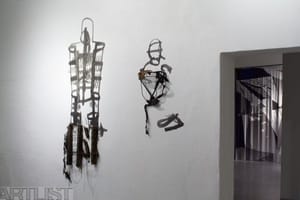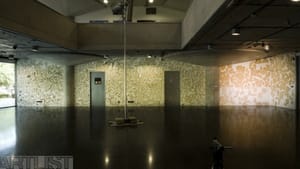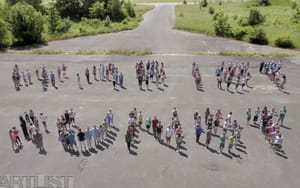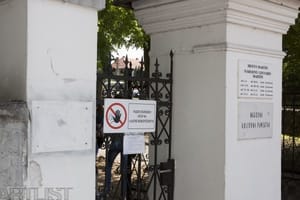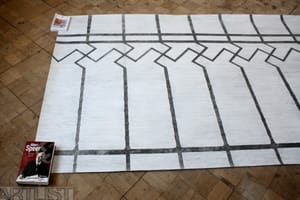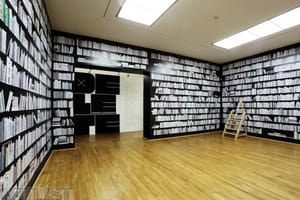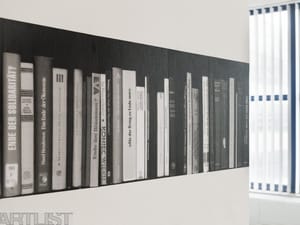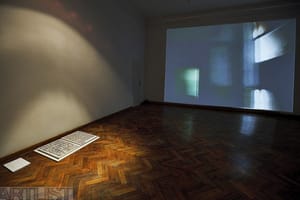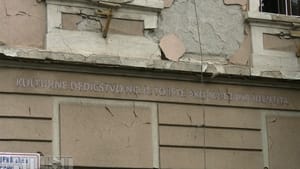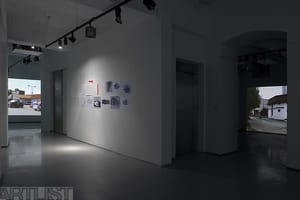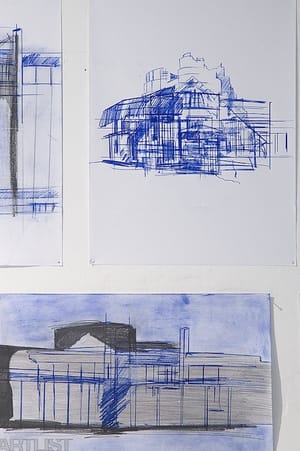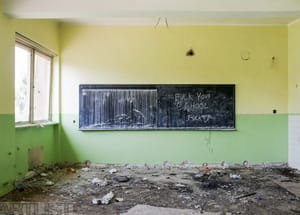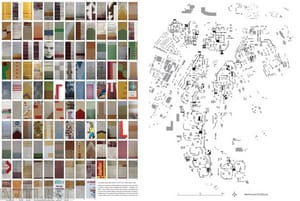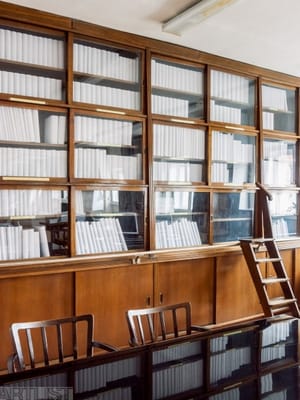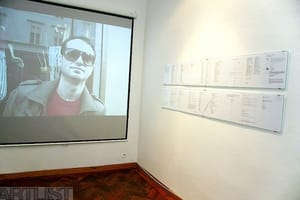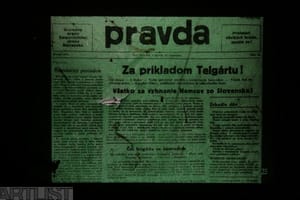- First Name
- Jaroslav
- Surname
- Varga
- Born
- 1982
- Birth place
- Trebišov, Slovakia
- Place of work
- Praha
- Website
- jarovarga.net
- Keywords
- CSU Library
- ↳ Find in the catalogue
About artist
Several basic motifs appear and are developed in the work of Jaroslav Varga. His main theme is the city and its transformation, deformation and elements of disappearance. He works with history but always connects, confronts and reflects upon it in light of the present, which he places within a broader historical framework. He investigates contemporary awareness of the city and the life being led in it and creates urban maps of disappearing, existing and newly created sites.
One aspect of modern settlements is the deformation of the local historical context and our insensitivity to their legacy. Varga’s work Three Routes (2007) following the intersecting paths of the history of Hungary, Germany and Slovakia culminated in the project FU JA RA (2011). The figure of Jánošík was depicted and interpreted many times over in Slovak culture. In his video Varga focuses on an interview with an actor who, disguised in the centre of Bratislava, “introduces” the famous warrior to groups of tourists while playing the shepherd’s pipe. For the guide it is tempting when dealing with crowds of tourists to use comparisons like Robin Hood or the didgeridoo, which, however, are ridiculous within the local context. The figure of Jánošík in its way lives its own life within a twisted, anecdotal narrative.
The intervention in public space made in Komárno (2010) is a reflection on the multi-ethnic coexistence on the border of Slovak and Hungary. The artist placed an inscription on the facade of a historical building that never in fact existed in this spot that read “Cultural heritage is not the same as national identity” in Slovak and Hungarian. The traces of the physical letter ask a question of the function of the depicting and the depicted and the material and ephemeral remains of history.
The artist researches a similar fictional lost inheritance in I Found it Somewhere, but I Cannot Find It (Martin, 2013), in which he questioned the local populations regarding the location of an allegedly lost memorial plaque to victims of the holocaust and then created clues to these plaques in the places named. In doing so he created a kind of non-existent memorial that is lost in history even in its fictive form.
Other projects by Varga focusing on linking the past and the present are centred on the Petržalka housing estate in Bratislava. This is the largest such estate in Central Europe, built during the era of “normalisation”, and is an independent urban phenomenon. The plans for its construction were conceived of very ambitiously by the then communist authorities. In the project Re: the Petržalka Apartment (2010) Varga put together a set of requirements for an apartment in this locality using the original conditions of the architectural tender and sent them to estate agents. The project output included not only documentation of the properties offered the artist, but also a range of reactions on the part of individual agents to the somewhat unusual criteria Varga had stipulated.
The series of prints entitled Vertical Labyrinth, 2009, is also based on the Petržalka housing estate and documents the state of the murals located on the side walls of individual blocks. This powerful visual layer offering another view of standardised prefab buildings could serve as a kind of guide to the “labyrinth”, a foothold in space.
Varga also occupies the role of urban explorer in his native Trebišov. These urban surveys are again based on the history of the place and reflect its current state and potential (non)future. Varga paid special attention to the building of the old junior school that he himself attended. The institution was closed down and the dilapidated building was finally demolished and replaced by a supermarket. The artist’s two-year-long research culminated in the cycle Shrinking City Expanding Memory – Urban Exploration I-VI, 2010).
The installation Comenius 1 (2010) recycles the only material the artist found in the old building, namely old training films. He screened these films on the old walls and then shot the projection. The new visual component thus replaced and emptied out the original content of the films, just as the new architecture replaced the old and the ideals of the former ideology became invalid.
Another location that Varga is engaged intensively in is the former military area in Milovice. This space served three armies successively (the Austro-Hungarian, German and Soviet, which only left it in 1989) and is now a deserted, dilapidated location surrounding by the small town. Varga reflects on the present or possible future state of the building while mirroring its history. In the installation Budoucnost historie / The Future of History (2013) he gathered fragments of murals from all three periods of the military history of the area as though conducting an archaeological dig, and then reconstructed them in a gallery. The wall framed a space through which history passed and now designates only emptiness and abandonment.
The artist also worked with the population of Milovice, a town originally built as the example of complete self-sufficiency but now surrounded by ruins. As well as discussions on the history and future of the town, he organised a happening with children frm the local junior school linking up to the event organised by the Slovenian group IRWIN Was ist Kunst? (Návrat do budoucnosti I / Return to the Future I, 2013). In the installation Lost Things (2014) he collected parts with an almost surrealist effect that he collected in the buildings and placed them within a new context in the gallery.
Varga accentuates not only the connection between the local urban space and history but also modern life in all its guises.
In Little Big City (2008) he created a map of new development projects in Bratislava. These projects have English titles and their artificially created titles do not relate to the local, historical or social context in any way. The project included the video documentation of a survey carried out in the streets of Bratislava in which the local population tried to translate these international tittles into Slovenian. The video then reveals the genuine influence of newspeak and the overuse of foreign names and anglicisms in real life.
The project De-architekturalizace I-VI / De-architecturalisation I-VI (2010) documents, analyses and typologises the architecture that is evolving in small towns at the rapid pace of the post-revolutionary economy. These buildings, often foreign, bizarre or even parasitical in appearance, are depicted by Varga in a series of documentaries, drawings and videos.
Another theme Varga has long been involved in is that of the library. The library as symbolic construct, the storage point of knowledge and a directive instrument that can serve ideology. Varga organised several site-specific installations and interventions in public libraries (the National Technical Library in Prague, the National Library in Warsaw, the Library of Slippery Rock University v Pittsburgh, and the Library of the Academy of Fine Arts in Bratislava). In several interventions he worked with the book as with a tabula rasa in which we wrapped all books in the same white paper (Untitled, 2008). In Knihovna / Library (2011–2012) the participative character of the event allowed visitors to give their own titles to empty book spines.
In Untitled III (2009–10) he gathered more than a hundred books in the National Library making some kind of reference to the end and from a photocopy of their spines created a fictional order of books concerned with the ambiguous phenomenon of “endism”.
Varga documented libraries destroyed during the second world war, especially in Poland, in his series Lost Libraries, 2012.
As well as artist Varga is also a curator. Along with Dorota Kenderová he has been curator of the Hit Gallery in Bratislava since 2007. At present he works in the MeetFactory Gallery in Prague.
- Author of the annotation
- Kateřina Štroblová / Rathouská
- Published
- 2015
CV
2011
doctoral internship Academy Day bildenden Künste, Wien
2010–2014Academy of Fine Arts and Design in Bratislava, doctoral studies (Németh, Edit András)
2005–2010Academy of Fine Arts and Design in Bratislava, Department of Intermedia and Multimedia, Studio IN (Ilona Németh, Andreas Fogarasi, Szabolcs KissPál)
2000–2005University in Prešov, Faculty of Humanities and Natural Sciences, Department of Arts
2009Slippery Rock University of Pennsylvania, Department of Fine Arts, USA
2007Akademia sztuk Pięknych, Wroclaw, PL
Awards:
2012Henkel Award finalist
2010Oskár Čepan Award Finalist
Finalist Start Point, GASK
2008Finalist Oskar Čepa Prize
Exhibitions
- Solo exhibitions
-
2014
Was ist Kunst, Galéria HIT, Bratislava, SK
Situace 50, Galerie Pavilon, Praha, CZ
2012
Konec vesmíru, Berlínskej model, Praha
O udalostiach posledných dní (s Dorotou Kenderovou), Galerie etc., Praha
Master and Disciple 4, Ilona Németh & Jaro Varga, Magma Contemporary Art Space, Sfântu Gheorghe, RO
Lost Library, Gallery Heppen Transfer, Varšava, PL
My sme podstavec, Vymenník, Košice, SK
Intervencion 2012, Public art project Trebišov, SK
2010
Open Studio, Karlín Studios, Praha
Urban Exploration/Mestský prieskum, Open Gallery Bratislava, SK
Touristic Routes, D Raum Museums Quartier, Wien, A
2009
Library in Library, Bailey Library, Slippery Rock University, USA
2006
Tourist Route, Street art project, Nitra, SK
Dangerous sequences, Gallery HIT, Bratislava, SK
- Group exhibitions not included in ARTLIST.
-
2015
Soft Codes, Museum of Contemporary Art in Wroclaw, PL
Tektonika paměti, Dům umění, BrnoPrivate Nationalism, Open Gallery, Bratislava, SK
2014
Tektonika paměti, Galerie Emila Filly, Ústí nad Labem
The First Man Was an Artist, Central Slovakian Gallery, Banská Bystrica, SK
Platonovo třetí oko, Meetfactory, Praha
Private Nationalism, Ostrale, Dresden, DE
Private Nationalism, Zsolnay Cultural Quater, Pécs Gallery m21, Pécs, HU
Ptolemaiovy děti, Galerie NTK, Praha
Private Nationalism, Kunsthalle Košice, SK
Circular Ruins, French Institute in Prague, MeetFactory, Praha
Private Nationalism, Divus, Praha
2013
Dysraphic City, Kunstraum Kreuzberg/Bethanien, Berlin, DE
Open studio, Triangle Arts Association, New York City, USA
Metaphysik der Disziplin, Czech Center, Berlin, DE
Vulnerable Failures, National Art Studio Chang-Dong, Museum of Modern and Contemporary Art in Korea, Seoul, South Korea
„Katalog Entropii Sztuki“, Galeria Entropia, Wroclaw, Poland
Prague Biennale 6, PrahaSubterranean Echoes, Center for Art and Urbanism, Berlin, DE
Blind spot, Galerie NTK, Praha
Panel Story, Bratislava City Gallery, Bratislava, SK
M(i)esto medzi pamäťou a nepamäťou, Turčianska galéria, Martin, SK
Panel Story, Turčianska Galéria, Martin, SK
2012
The Discovery of Slowness II, Tranzit SK, Bratislava, SK
On Boredom, Kulturfabrik TABAČKA, Košice, SK
Delete. Art and Wiping out, Slovak National Gallery, Bratislava, SK
Zlínsky salón mladých 2012, Dům umění, Zlín
2011
Eleventh Hour, Futura, Praha
Public Folklore, Grazer Kunstverein, Graz, AT
Why do I keep reading the same books?, AMT project, Bratislava, SK
MAPY/MAPS, Bratislava City Gallery, Bratislava, SK
LIBRARIANISM, Galerie NTK, Praha
PRIMS, The Orchard Centre, Sheffield, UK
TWIST- Tuica/Tusovka, 91mQ Art project space, Berlin, DE
2010
“Where do we go from here?”, Secession, Wien, AT
“Der Drang nach Osten”, Galéria HIT Bratislava, SK
Transart Communication- Public Dialog, Komárno, Komárom, SK/HU
Startpoint, Galerie středočeského kraje, Kutná Hora
Priestor / Prostor Z(I)LIN(A), Povážská Galéria, Žilina, Krajská galerie, Zlín, SK/CZ
Výstava finalistů Ceny Oskára Čepana, Galéria Medium, Bratislava, SK
Perfection, Galéria Medium, Bratislava, SK
The Romance of my Young Days, the Future of my Nostalgia, Central Slovakian Gallery, Banská Bystrica, SK
Open Studio, Karlin Studios, Praha
Touristic Routes, D Raum Museums Quartier, Vienna, AT
2009
Rhetoric of Fiction, Kino HVIEZDA, Banská Bystrica, SK
Exit Ghost, Gallery Valentina Moncada, Rome, IT
Fantazies of Beginning Documentation, Central Slovakian Gallery Banská Bystrica, SK
BRATISLAVA, Slovak Cultural Institute, Rome, IT
Fantazies of Beginning, Billboard Gallery Europe, Bratislava, SK
2008
Library in Library, Bailey Library, Slippery Rock University, USA
Videokunst vs künstlerische Dokumentation, KOLONI, Dresden, DE
Exhibition of finalists of Oskar Cepan Award, Galéria Medium, Bratislava, SK
ENDING, One-week international art residency at Hotel Kyjev, Bratislava, SK
2007
International Media Art Biennale WRO 07, Wroclaw, PL
SURVIVAL, Public Art Festival in Wroclaw, PL
BEST WEST, Gallery Entropia, PL
BRIDG:ING, Gallery of Ministry of Culture of Slovak Republic, Bratislava, SK
TACTICS OF RESISTANCE X GLOBAL POLICE ACTION, Exhibition Centre Constantin Brancusi, Chisinau, MD
- Collections
- Slovenská národná galéria, SKZámek Třebešice, CZZachęta Collection, Wroclaw, PL
- Other realisations
kurátorské projekty:
2014
Revolution without Movement (s Berit Fischer a Dorotou Kenderovou), Galeria HIT & tranzit.sk, Bratislava SK/AT (s Ivanem Juricou, Martinou Šimkovičovou, Pavolem Trubenem, Silvií Saparovou), mo:e Wien, A
2012
On Boredom (s Dorotou Kenderovou), Tabačka Kulturfabrik, Košice The Discovery of Slowness II, (s Dorotou Kenderovou), tranzit.sk, Bratislava The Discovery of Slowness I, (s Dorotou Kenderovou), Tabačka Kulturfabrik, Košice
Monography
- Monography
VARGA, Jaroslav; Kenderová, Dorota (eds.). Is the Future Boring? Bratislava: Galéria HIT, 2014.
VARGA, Jaroslav. Untitled. Bratislava, 2014.
- Articles
JAKALOVÁ, Zuzana. Jaro Varga: Niekde som to našiel, ale neviem to nájsť. Flashart, 2015, 35, 35.
SÝKOROVÁ, Lenka. Galerie jako jeskyně stínů. artalk.cz, 27.10.2014, <http://www.artalk.cz/2014/10/27/galerie-jako-jeskyne-stinu/>.
KUKUROVÁ, Lenka. Čo je za umením? artalk.cz, 30.8.2013, <http://www.artalk.cz/2013/08/30/co-je-za-umenim/>.
JANEČKOVÁ, Zuzana. Pôdorys premenlivosti v m(i)este medzi pamäťou a nepamäťou. artalk.cz, 13.7.2013, <http://www.artalk.cz/2013/07/13/podorys-premenlivosti-v-mieste-medzi-pamatou-a-nepamatou/>
MEGYEŠI, Peter. Pestrý obraz sídliskovej šedi. artalk.cz, 14.6.2013, <http://www.artalk.cz/2013/06/14/pestry-obraz-sidliskovej-sedi/>.
VARGA, Jaro. Knihovna 2011. A2: kulturní čtrnáctideník, 2012, 24. ISSN 1803-6635.
